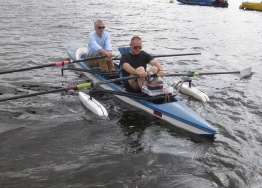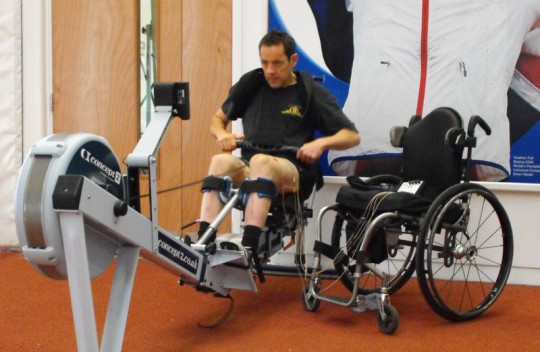FES Rowing Training
Introduction
This section reviews the current FES-assisted training protocols. These protocols were developed with the latest version of the DEMAND FES-rowing machine. Click on the sections to the left to view training centres that currently offer FES rowing training.
Please note the following
The FES-assisted training protocols detailed in this section were specifically developed for the equipment they were to be used with. The very nature of FES-assisted exercise also involves risks not associated with conventional voluntary upper body exercise modalities and should not therefore be attempted without the supervision of a professional clinician, physiotherapist or researcher that has been trained in the use of FES-assisted exercise.
FESrowing is not responsible for injury caused by anyone disregarding this warning.
DEMAND FES Rowing System
Basic training protocols were developed for the DEMAND 4-channel FES rowing system by the UK FES Rowing Group in 2003. These protocols were further developed and refined into a training programme during a pilot study conducted by Robin Gibbons in 2005. The training protocols developed in this pilot study were subsequently incorporated into a draft training guide in 2007. The FES Rowing Training Guide draft Version 1 has been uploaded for information. The guide is currently undergoing substantial amendment following on-going evaluation and recent development in a pilot study to evaluate 8 and 12-channel FES rowing systems. These multi-channel systems are designed to optimise cardiorespiratory and skeletal health in people with SCI by recruiting greater active musculature.
The current training protocols used with the latest 2010 version of the DEMAND 4-channel FES rowing system are being continuously evaluated to optimise training technique and rowing performance whilst ensuring safe and efficient training of people with SCI. To date, over 30 individuals with complete and incomplete lesions from C4 to T12 have participated in numerous scientific studies in the UK using these protocols with the 4-channel system. The current training programme has three inter-related phases.
Male with a complete T2 SCI during a 30-min FES rowing training session
Phase 1
Initial FES leg conditioning can be conducted in a seted position from an individuls own wheelchair, or whilst laid supine on a bed or sofa providing the thighs are supported with knees flexed at 90°; feet hanging freely and unrestricted with gravity. The feet and ankles
should be appropriately cushioned to prevent injury. Phase 1 involves quadriceps-only conditioning to gradually increase muscle strength and endurance. Hamstring conditioning is integrated into the programme once at least 10 minutes of continuous 90° knee extension exercise is possible. The aim of Pgase 1 is to achieve at least 30 minutes of continuous 90° knee extension exercise on up to 7 days per week. FES rowing is then integrated into the programme.
Phase 2
FES rowing training starts with an interval training regime on alternate days, three days per week whilst FES leg conditioning continues for up to 60 minutes of 90° knee extension
exercise on non-rowing days as background muscle conditioning. Interval rowing training involves FES rowing for 30 seconds followed by arms-only rowing for 30 seconds and progressively builds to 30 minutes duration. On reaching 30 minutes, the FES rowing component is increased by 10 seconds to a 40:20 second split. Occasionally, a 50:10 split is required before non-stop FES rowing is possible for 30 minutes. Phase 3 of the programme commences when participants can non-stop FES row for 30 minutes on three alternate days per week, whilst FES leg conditioning for 60 minutes on the remaining non-rowing days.
Phase 3
Non-stop FES rowing performance is developed during this phase of the programme whilst optimising rowing technique. Two rowing styles are currently being evaluated in the cohort of UK FES rowers. These will be reported in the Scientific Articles section of this site in due course. To optimise training potential, FES rowing continues on three alternate days per week for 30 minutes of moderate-intensity exercise whilst base-line FES leg conditioning continues on the remaining 4 days per week for 60 minutes of low-intensity exercise. Moderate intensity exercise is defined as 40% - 60% of a pre determined peak exercise capacity. See Scientific Articles. This volume, intensity and frequency of exercise align with the American College of Sports Medicine (ACSM) recommended guidelines to optimise cardiovascular fitness and general health in the general population.
Return to FES Rowing Training






